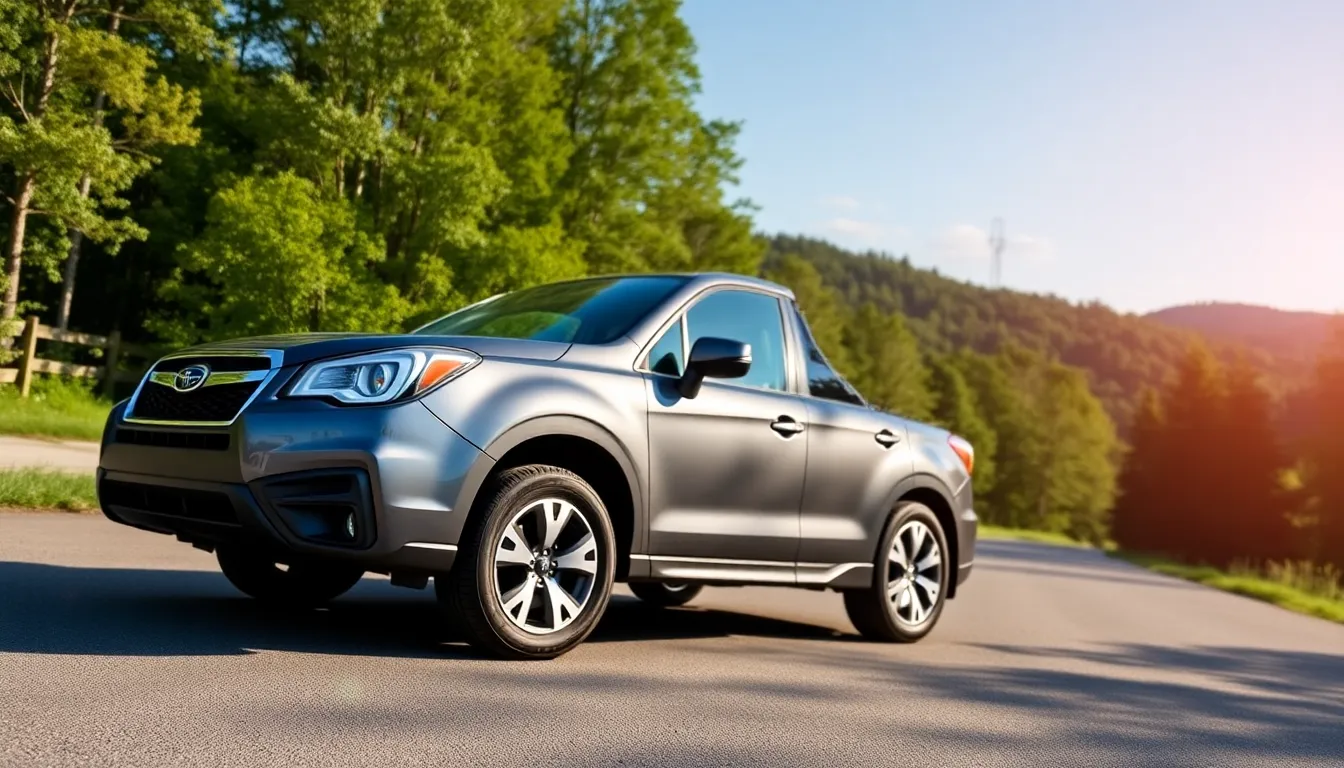Are you trying to figure out the correct tire size for your 2017 Subaru Forester? Understanding your vehicle’s proper tire specifications is crucial for optimal performance, safety, and handling.
When it comes to the 2017 Subaru Forester, tire sizes vary depending on the exact trim level you own. The standard tire size for most 2017 Forester models is 225/60R17, though some premium trims might come equipped with 225/55R18 tires. Knowing your exact specifications isn’t just about replacement—it affects everything from fuel economy to how your vehicle handles in various driving conditions.
Understanding Tire Sizes for the 2017 Subaru Forester
Tire size specifications on your 2017 Subaru Forester consist of three main components: width, aspect ratio, and rim diameter. The standard format appears as a sequence like “225/60R17” where each number serves a exact purpose. Breaking down this example, “225” represents the tire width in millimeters, “60” indicates the aspect ratio (height as a percentage of width), and “17” specifies the rim diameter in inches.
Most 2017 Forester models come equipped with 225/60R17 tires as standard equipment. Higher trim levels such as the Touring and XT Premium feature larger 225/55R18 tires for enhanced performance. These measurements aren’t arbitrary—Subaru engineers selected these exact dimensions to balance handling, comfort, and fuel efficiency.
Many Forester owners report noticeable differences when switching between these tire sizes. Liam Kohn, a longtime Forester enthusiast, discovered that the 18-inch wheels provided better cornering stability on winding mountain roads but slightly reduced fuel economy compared to the standard 17-inch setup.
Additional tire markings include load index and speed rating, appearing as numbers and letters after the size (e.g., 95H). The load index—”95″ in this example—corresponds to the maximum weight each tire can safely carry. Speed ratings like “H” indicate the maximum sustained speed capability, with H-rated tires certified for speeds up to 130 mph.
These specifications directly impact your Forester’s handling characteristics, ride comfort, and fuel efficiency. Deviating significantly from factory specifications risks compromising safety features like antilock braking and stability control systems that were calibrated for exact tire dimensions.
Factory Stock Tire Specifications for the 2017 Forester
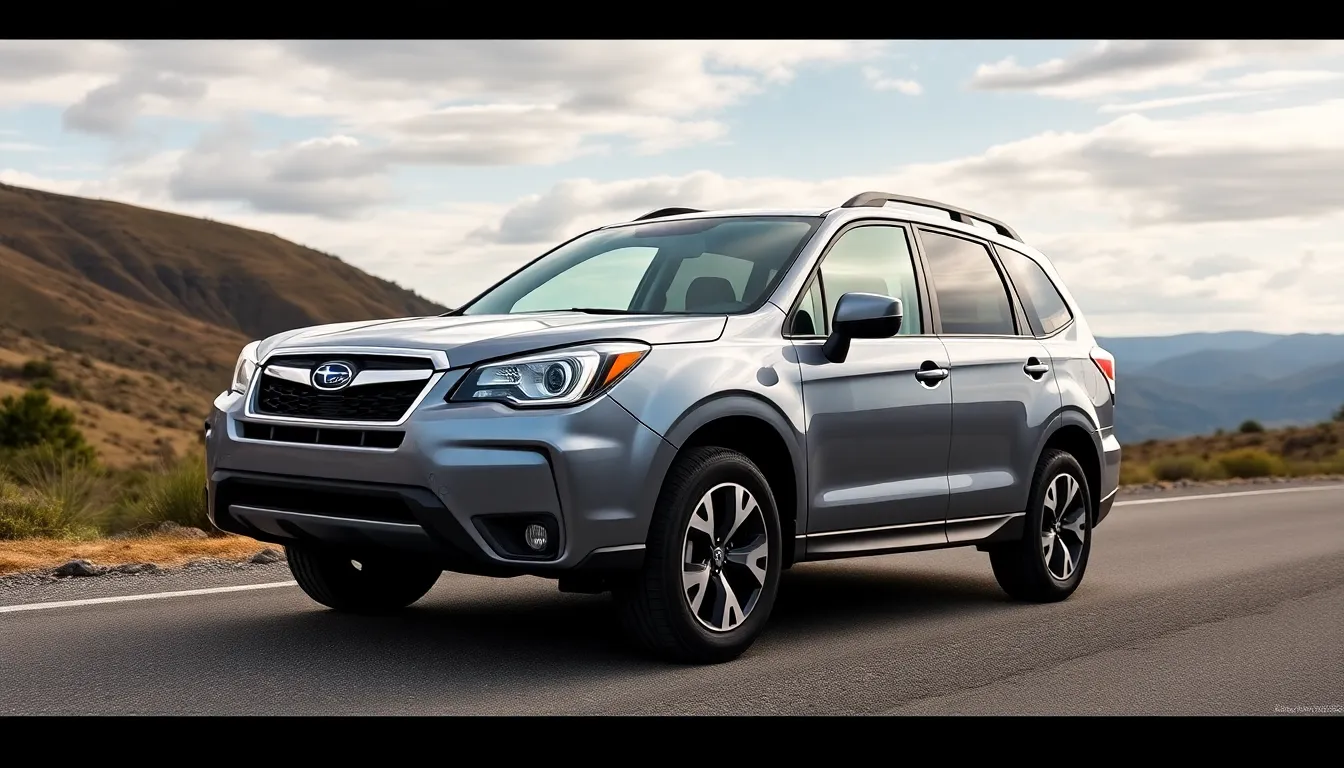
The 2017 Subaru Forester comes equipped with exact tire sizes that vary across different trim levels. Each tire size is carefully selected by Subaru engineers to complement the vehicle’s performance characteristics and intended use.
Base Model Tire Size
Base model 2017 Foresters feature 225/60R17 tires as standard equipment. These tires offer an excellent balance of comfort, traction, and fuel efficiency for everyday driving situations. The 225mm width provides sufficient road contact for stability, while the 60% aspect ratio helps absorb road imperfections and deliver a comfortable ride. Many Forester owners appreciate this tire size for its versatility in handling various road conditions without compromising the vehicle’s fuel economy.
Premium and Limited Trim Tire Sizes
Premium and Limited trims of the 2017 Forester typically maintain the same 225/60R17 tire size found on the base model. This consistent sizing across the 2.5i Premium and Limited variants ensures predictable handling characteristics throughout most of the lineup. The 17-inch wheels paired with these tires strike an ideal balance between appearance and practical performance. These tires carry appropriate load and speed ratings (typically 98H), guaranteeing they can safely support the vehicle’s weight while maintaining highway speed capabilities.
Touring Trim Tire Options
Touring trims upgrade to larger 225/55R18 tires mounted on 18-inch wheels for enhanced styling and performance. This size is also standard on the performance-oriented 2.0XT Premium and 2.0XT Touring variants, delivering more responsive handling and a sportier aesthetic. The reduced sidewall height (55 versus 60) results in less flex during cornering, providing more precise steering feedback. These larger tires typically come with speed ratings of 98V or 96V, supporting the higher performance capabilities of these premium trims while maintaining appropriate load-carrying capacity.
Decoding Subaru Forester Tire Size Markings
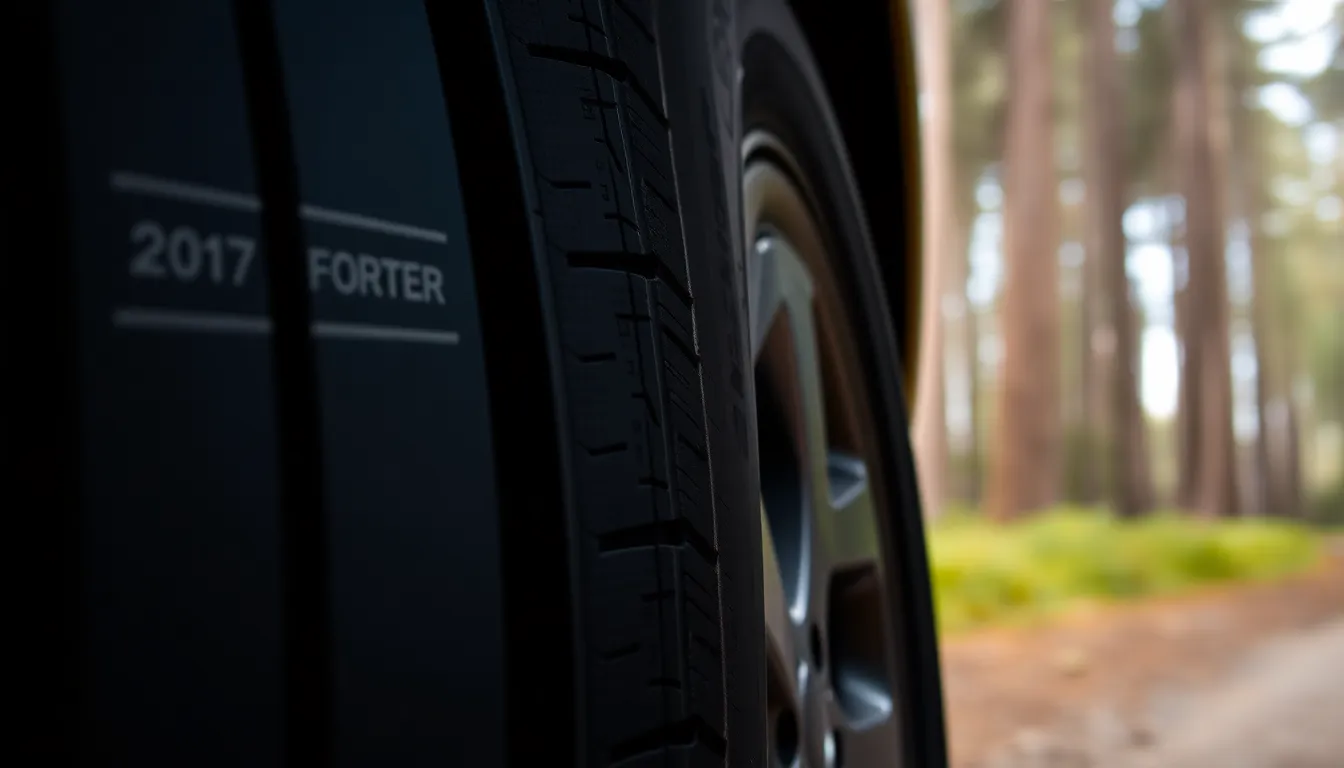
Tire size markings on your 2017 Subaru Forester contain critical information about dimensions, construction, and performance capabilities. Understanding these markings helps you select the right replacement tires that maintain your vehicle’s handling, safety, and ride quality.
What the Numbers and Letters Mean
The standard 225/60R17 tire size for the 2017 Subaru Forester breaks down into exact measurements that affect your driving experience. The first number “225” indicates the tire width in millimeters from sidewall to sidewall. Your tire’s aspect ratio follows next, with “60” meaning the sidewall height equals 60% of the tire’s width. The letter “R” stands for Radial construction, the industry standard for passenger vehicles. Finally, “17” represents the wheel diameter in inches, confirming the tire fits a 17-inch rim. These specifications work together to create the balanced ride Subaru engineers designed for your Forester.
Load and Speed Ratings Explained
Load and speed ratings appear as additional markings after the tire size and directly impact your Forester’s safety margins. The load index consists of 2-3 digits indicating maximum weight capacity per tire – for example, a load index of 94 means each tire supports up to 1,477 pounds. Speed ratings appear as letters following the load index, with an “H” rating allowing sustained speeds up to 130 mph. Replacement tires must match or exceed your Forester’s original load and speed ratings to maintain proper handling characteristics and safety features. These ratings ensure your tires can handle the vehicle’s weight during cornering, braking, and acceleration while providing adequate heat resistance at highway speeds.
Upgrading Your 2017 Forester Tires

Upgrading your 2017 Subaru Forester tires lets you customize performance characteristics to match your driving needs. The right tire choice can significantly enhance your Forester’s capabilities while maintaining safety and reliability.
Compatible Alternative Tire Sizes
The 2017 Subaru Forester comes factory-equipped with either 225/55R18 or 225/60R17 tires depending on your trim level. Higher-end trims like the 2.0XT Premium and Touring models typically feature the 225/55R18 size, while other versions come with 225/60R17 as standard equipment. Both sizes use similar rim specifications with 7-inch widths and an ET48 offset, providing consistent fitment across models.
For owners seeking alternatives, 215/65R16 tires represent a compatible option that fits 6.5Jx16 rims with ET48 offset. This size offers a slightly different profile while maintaining proper clearance and functionality. When considering alternative sizes, it’s critical to match the original diameter and overall tire circumference as closely as possible to prevent speedometer inaccuracies and preserve handling characteristics.
Tire alternatives must be selected with careful attention to wheel clearance and suspension specifications. Deviating too far from factory specifications can affect your Forester’s advanced safety systems and handling dynamics negatively.
Performance vs. All-Season vs. All-Terrain Options
Performance tires deliver enhanced road grip and responsive handling for your Forester, making them ideal for spirited driving on paved roads. These tires typically feature stiffer sidewalls and specialized tread patterns that improve cornering abilities and wet-weather traction. The trade-off comes in the form of faster wear rates and potentially harsher ride quality compared to other options.
All-season tires offer the most versatile option for most Forester owners, providing balanced performance year-round. Models like the Hankook Kinergy GT H436 deliver reliable traction in dry, wet, and light winter conditions while maintaining comfortable ride characteristics. These tires typically come with longer tread life warranties, ranging from 40,000 to 80,000 miles depending on the exact model.
All-terrain tires feature aggressive tread patterns designed for off-road capability without sacrificing on-road comfort. Options like the Cooper Defender 2 provide enhanced grip on unpaved surfaces, making them perfect for Forester owners who regularly venture onto gravel roads, light trails, or snowy conditions. The deeper tread depth and reinforced construction offer additional protection against punctures and cuts when driving on rough terrain.
The Goodyear Proxes STIII, Tiger Paw Touring AS DT, and Cooper Discoverer EnduraMax represent just a few of the quality tire options available in the common 225/55R18 size used on the 2.5i Touring trim. Each model offers different strengths in terms of noise levels, comfort, traction, and longevity, allowing you to prioritize the characteristics that matter most for your driving habits.
Seasonal Tire Considerations for the Forester
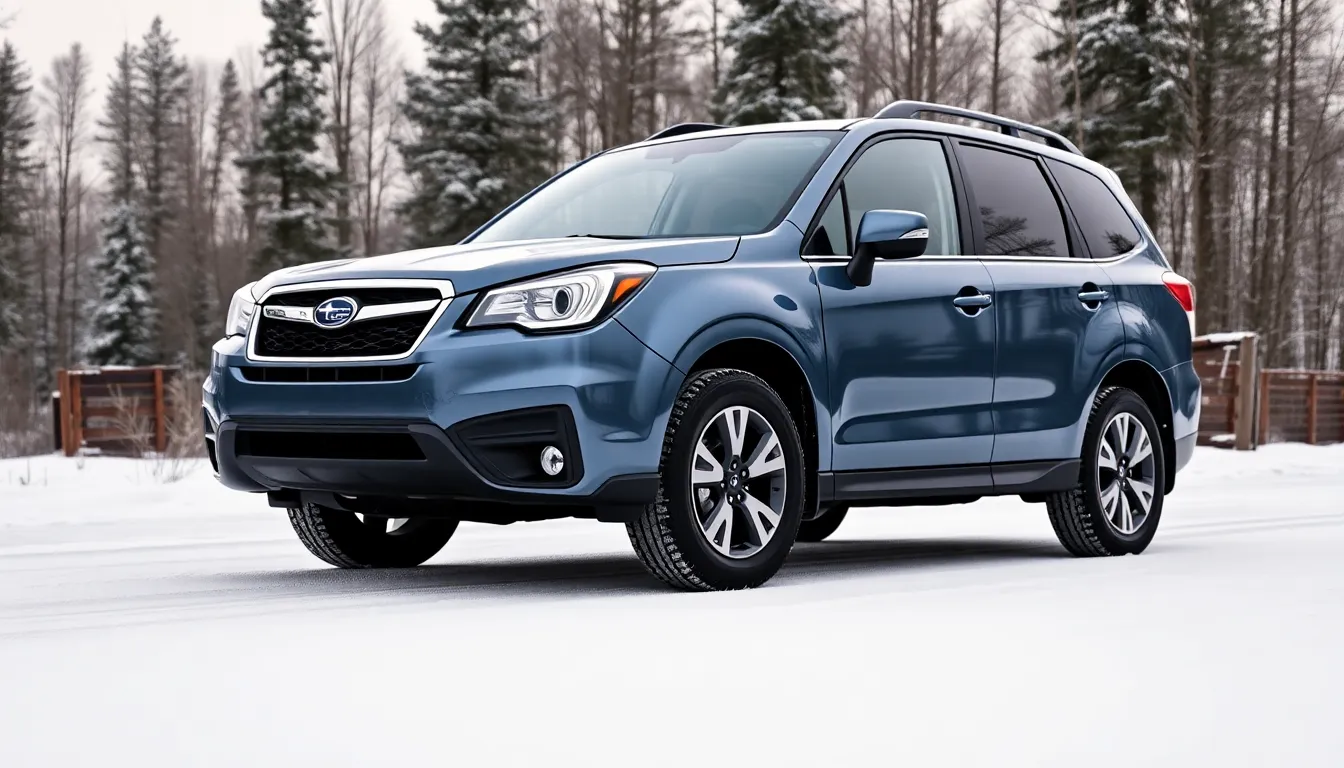
Seasonal conditions significantly impact your 2017 Subaru Forester’s performance, safety, and handling characteristics. Choosing the right tires for different weather conditions ensures optimal traction and control throughout the year.
Winter Tire Recommendations
Winter tires provide superior grip and braking performance on snow and ice due to their specialized rubber compounds and tread patterns. For your 2017 Forester, select winter tires that match your original equipment size—either 225/55R18 or 225/60R17—to maintain compatibility with your exact trim level. These dedicated winter tires feature rubber formulations that remain flexible in freezing temperatures and aggressive tread patterns designed to channel snow and slush away from the contact patch. Enhanced braking distances on icy roads make winter tires a crucial safety upgrade for anyone driving in regions with regular snowfall or frequent below-freezing temperatures.
Summer and All-Weather Performance
All-season tires come standard on the 2017 Forester, offering a balanced approach to traction, wear resistance, and comfort across moderate weather conditions. For enhanced warm-weather performance, summer tires deliver improved handling and responsiveness on dry roads but lack winter traction capabilities. All-weather tires present a practical middle ground, performing adequately in mild winter conditions while still maintaining good warm-weather characteristics. Maintaining the correct tire size—225/55R18 for higher trims like the 2.0XT Premium and Touring or 225/60R17 for other configurations—ensures your Forester retains its factory-engineered ride quality, handling precision, and accurate speedometer readings. The right seasonal tire choice optimizes your Subaru’s all-wheel-drive system performance, complementing its capability in various driving environments.
Maintaining Proper Tire Pressure and Rotation
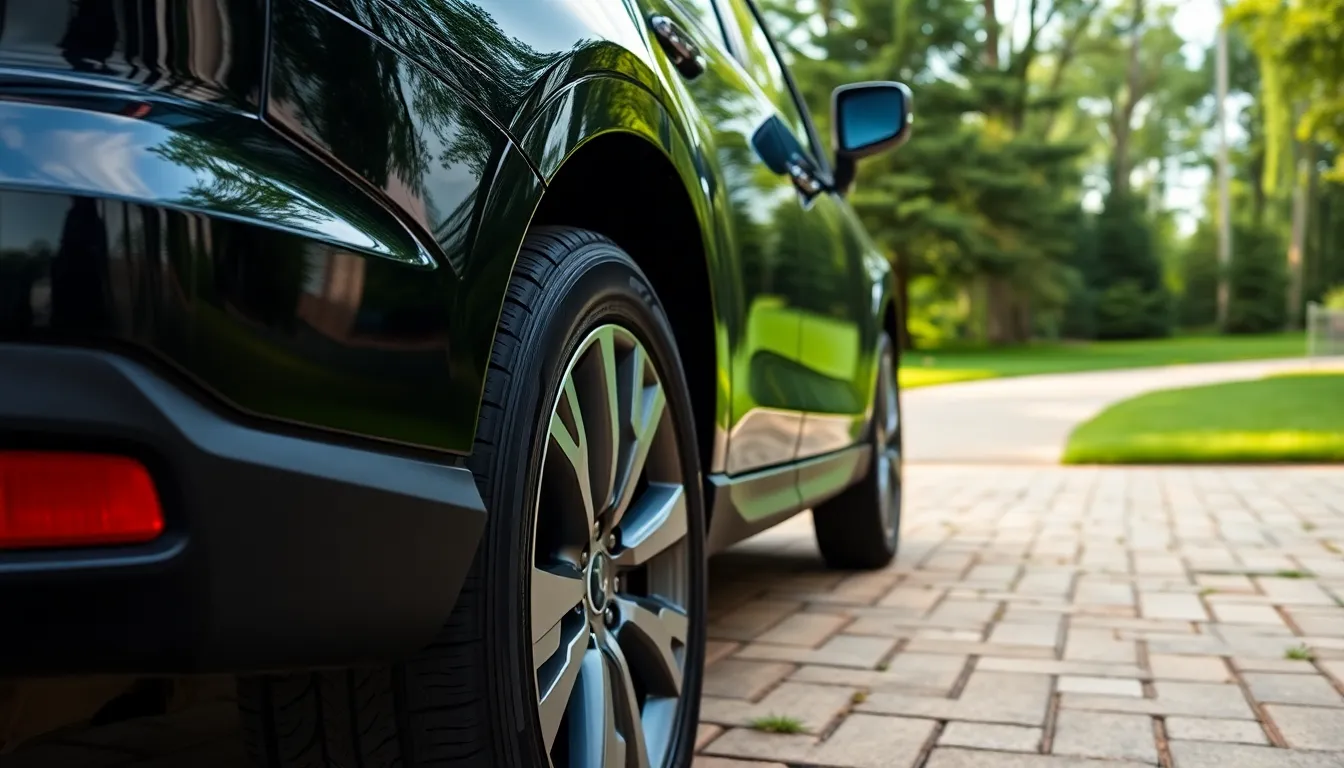
Proper tire maintenance significantly extends the life of your 2017 Subaru Forester tires and optimizes vehicle performance. Regular pressure checks and rotation schedules create a foundation for tire longevity and consistent handling characteristics.
Recommended Tire Pressure
The 2017 Subaru Forester requires exact tire pressure levels based on the tire size. For the standard 225/60R17 tires, maintaining the manufacturer-recommended pressure ensures optimal contact with the road surface. Models equipped with the larger 225/55R18 tires (found on 2.0XT Premium and Touring trims) need precise pressure monitoring to balance comfort with responsive handling.
Tire pressure specifications are conveniently located on a placard inside the driver’s door jamb or in your owner’s manual. Checking pressure when tires are cold delivers the most accurate readings, as heat from driving temporarily increases pressure measurements.
Tire Rotation Schedule
Rotating your Forester’s tires every 6,000-8,000 miles promotes even wear patterns across all four tires. The AWD system in Subaru vehicles makes regular rotation particularly important since uneven tire wear can affect drivetrain components.
A standard rotation pattern for the Forester typically involves moving the front tires to the opposite rear positions while bringing the rear tires forward on the same side. This pattern addresses the different wear characteristics between front and rear positions in AWD systems.
Benefits of Proper Maintenance
Consistent tire maintenance delivers multiple advantages for your 2017 Forester. Properly inflated tires maximize fuel efficiency by reducing rolling resistance. Correct pressure levels also enhance handling precision and braking performance in various driving conditions.
Regular rotation schedules extend tire life by distributing wear evenly, potentially saving hundreds of dollars over the vehicle’s lifetime. Both maintenance practices work together to preserve the engineered safety features and performance characteristics Subaru designed for the Forester.
Conclusion
Selecting the right tire size for your 2017 Subaru Forester is essential for maintaining its performance and safety capabilities. Whether you stick with the factory specifications (225/60R17 for most models or 225/55R18 for premium trims) or explore compatible alternatives your choice directly impacts handling fuel efficiency and ride comfort.
Remember that proper tire maintenance including regular pressure checks and rotations every 6,000-8,000 miles will extend tire life and preserve your Forester’s driving dynamics. The right tires also optimize your all-wheel-drive system and ensure accurate speedometer readings.
By understanding tire specifications and choosing options that match your driving needs you’ll enhance your Subaru’s performance in all conditions while maintaining the safety standards engineered into your vehicle.
Frequently Asked Questions
What is the standard tire size for a 2017 Subaru Forester?
The standard tire size for most 2017 Subaru Forester models is 225/60R17. Higher-end trims like the Touring model come equipped with 225/55R18 tires. These specifications were carefully selected by Subaru engineers to provide an optimal balance of performance, comfort, and fuel efficiency for the vehicle.
What do the numbers in the tire size 225/60R17 mean?
In the tire size 225/60R17: “225” represents the tire width in millimeters, “60” is the aspect ratio (height as a percentage of width), “R” indicates radial construction, and “17” is the wheel diameter in inches. These specifications work together to create the balanced ride characteristics that Subaru designed for the Forester.
Can I use a different tire size on my 2017 Forester?
While it’s possible to use alternative tire sizes, they should match the original diameter and circumference closely. Options like 215/65R16 may work if they maintain similar overall dimensions. Using significantly different sizes can affect speedometer accuracy, handling, and the functioning of safety systems like ABS and stability control.
What are the different types of tires available for the Forester?
The main types include: performance tires for enhanced grip and handling; all-season tires for versatile year-round use; and all-terrain tires for off-road capability. Your choice should align with your driving habits and conditions. Each type offers different benefits in terms of comfort, noise levels, and capability in various environments.
Do I need winter tires for my Subaru Forester?
Despite the Forester’s all-wheel-drive system, winter tires are recommended for driving in snow and ice conditions. They provide significantly improved grip and braking performance in cold weather. When selecting winter tires, match the original equipment size to maintain compatibility with your vehicle’s systems.
What is the correct tire pressure for a 2017 Forester?
The correct tire pressure depends on your specific tire size. For most 2017 Foresters, the recommended pressure ranges between 32-35 PSI. The exact specifications can be found on the placard inside your driver’s door jamb or in your owner’s manual. Maintaining proper pressure is crucial for safety, fuel efficiency, and tire longevity.
How often should I rotate the tires on my Forester?
Rotate your Forester’s tires every 6,000-8,000 miles or according to your owner’s manual recommendations. Regular rotation is particularly important for all-wheel-drive vehicles to ensure even wear across all four tires. This practice extends tire life and maintains optimal performance of the AWD system.
Will changing to larger tires affect my Forester’s performance?
Larger tires can provide better cornering stability and a more aggressive appearance, but may slightly reduce fuel economy. Any size change should maintain similar overall diameter to prevent issues with speedometer accuracy and drivetrain stress. Always consult with a tire professional before making significant changes.
What load and speed ratings are important for Forester tires?
Your replacement tires should match or exceed the original load index (weight capacity) and speed rating (maximum sustained speed) found on your factory tires. These ratings are critical for maintaining the Forester’s designed handling characteristics and safety features, especially during emergency maneuvers.
How do tire choices affect fuel economy in the Forester?
Tire selection significantly impacts fuel economy. Wider tires or those with aggressive tread patterns create more rolling resistance, reducing efficiency. Maintaining proper inflation is equally important—underinflated tires can decrease fuel economy by up to 3%. Stick with recommended sizes and quality tires for optimal efficiency.
